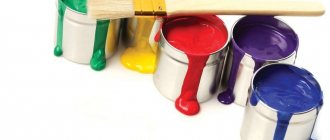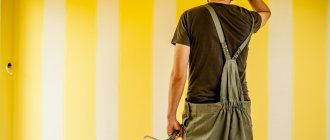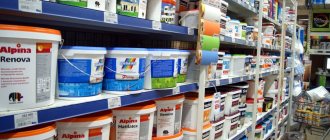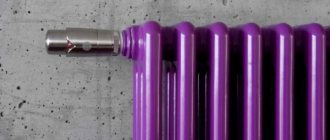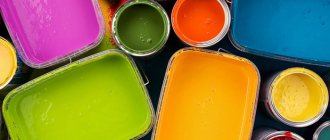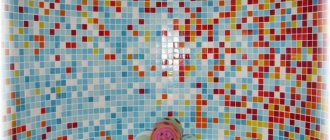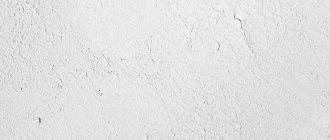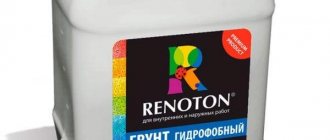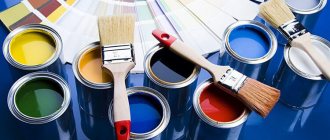Felix
4267 0 0
Felix October 23, 2017 Specialization: philological education. 20 years of experience as a builder. Of these, for the last 15 years he led a team as a foreman. I know everything about construction - from design and zero cycle to interior design. Hobbies: Vocals, psychology, quail breeding.
In damp rooms, the paint should repel water.
Greetings, my dear readers!
All buildings have rooms that are actively exposed to moisture. To finish them, waterproof paint is required. I will talk about their types and features in this article.
Tile vs waterproof paint
Until recently, tiles were considered the best option for finishing walls and ceilings. This material has many advantages. Firstly, tiles are wear-resistant. It is durable, withstands mechanical, chemical influences and, most importantly, the negative influences of water. Due to this, the tile retains its original performance properties and characteristics, as well as its attractive appearance for many years of use. In addition, from individual elements you can assemble an original mosaic or panel, which will also serve a decorative role. On the other hand, tiles also have obvious disadvantages:
- High cost of the material itself;
- The complexity of self-installation, which must be carried out in accordance with certain rules. This results in the high cost of working as a tile laying specialist.
- Tile is quite difficult to replace if you want to update the room.
Using waterproof paint allows you to get a durable result, and changing the color of the walls will not be difficult. Carrying out work on painting surfaces is not at all difficult: it is enough to have initial skills in using a paint brush or roller to evenly apply the composition. Compared to tiles, paint is relatively inexpensive, plus in stores you can find a variety of color and texture coating options, so you can decorate the room in an original way.
Just a few decades ago, painting bathroom walls evoked only negative associations: over time, the surface lost its original appearance, the paint itself cracked and literally fell off the wall and ceiling in whole pieces. The result is a sloppy appearance of the room and the need for repairs. Modern compositions demonstrate excellent wear resistance and make it possible to achieve an almost perfectly smooth surface.
Proper surface preparation is the key to success
In order for the paint to lay evenly and have a uniform shade without inclusions, it is necessary to prepare the surface for painting.
If there are any unevenness, plaster, prime and putty. To determine the evenness of the surface, a beacon is used, suspended on a rope to the extreme corner of the ceiling and wall on a thread. Such a hand-held beacon should hang freely, but close to the wall to determine gaps. They also use a building rule to determine unevenness. The error in curvature should not exceed 0.4 mm. Otherwise, alignment is performed. If the unevenness is too large and the walls are uneven in terms of brickwork, it is recommended to use plasterboard leveling on a profile frame.
Before painting the walls, be sure to prime the surface. After the soil has dried, painting activities are carried out.
What to putty on
Putty, regardless of the type of wall finishing in the bathroom, must have the following qualities:
- Moisture resistant.
- Heat resistance.
- Resistant to temperature changes.
Only two types of putty are suitable for application in the bathroom:
- Waterproof cement. It is made from high quality Portland cement, fine sand and crushed marble or clinker chips, plasticizers, modulators and hardeners. After applying a fresh coating, it is necessary to wet the wall with water for the first three days to reduce shrinkage in the future.
- Polymer moisture resistant. Produced on the basis of acrylic or latex, additives and synthetic mineral additives. They are flexible in operation, do not shrink, and are stored longer after preparation.
But gypsum compositions in the bathroom are completely unsuitable. At the first contact with water, such a surface will come off and swell.
How to plaster
Plaster used as a leveling for wall painting, as well as plaster, must have moisture-resistant and heat-resistant characteristics. In order to save money, cement compounds are used for leveling before painting or tiling.
Popular brands of suitable bathroom plasters:
- IVSIL THINER.
- Profit Hydrophobic.
- Ceresit CR 65.
- UNIS SILIN.
How to level
Leveling for very curved surfaces is used in the form of profile frame structures vertically, between which cement mortar or plaster is poured
If you use plasterboard gluing, you need to look at its performance characteristics: it is important to take into account the increased humidity in the room and the need to protect the blocks from its effects during the entire service life
You can prepare cement plaster for leveling yourself. To do this, you will need cement (grades M400, M500), fine sifted sand in a ratio of 1: 3. Additionally, 3 tablespoons of dishwashing detergent are poured into the prepared solution in a bucket. This component increases plasticity, but increases the drying time of the mixture on the walls.
The main advantages of waterproof paint
Their most important advantage is their water-repellent properties. They are due to the presence of special compounds in the composition, which form a thin film on the surface that does not allow water molecules to pass into the structure. In addition, there are a number of other advantages:
- Antiseptic properties . Walls, floors, ceilings and other surfaces treated with waterproof paint are not subject to the formation of mold. Fungus does not appear on them and bacteria do not multiply. This effect is observed for a long time after applying the coloring composition.
- Wear resistance . Waterproof paint is less susceptible to abrasion. The surface can be cleaned of contaminants using chemicals, and this can be done as often as possible - the coating will not lose its initially attractive appearance and will not lose its performance qualities and properties.
- Covers well and is economical . To get a beautiful surface, it is enough to apply only two layers of the composition, instead of 4-5.
- Environmental friendliness . Paint used in wet areas (for example, AQUATEX) is absolutely safe for humans and the environment. It does not emit toxic or other harmful substances - and these are the most basic requirements for comfortable living in any home.
A bathroom, a bathroom, and a kitchen are the most expensive to repair and decorate, so you should not skimp on the quality of work and paint for the walls - the attractiveness of the interior and the service life of the finishing materials themselves depend on this.
- Ease of application . Even a schoolboy can paint a wall! This process does not take much time and does not require special skills.
- Durability . Moisture-resistant paint is resistant to fading, and even after several years it retains its original shade. It adheres well to the prepared base and does not chip.
- Easy care . You can remove dirt with a regular damp cloth.
- Aesthetics . A wide selection of colors allows you to create a comfortable and pleasing environment - a bathroom needs this no less than a living room or bedroom.
To achieve maximum benefits, experts recommend using two paints: the base paint and the top coat. In the latter case, water-based latex compositions made on the basis of acrylate are most often used. If you follow all the rules of coloring, you get an even and beautiful coating.
Where to start painting bathroom walls
Before you start finishing work, you need to prepare in advance a set of tools that will be needed in the process.
- Spatula. You need both a narrow tool for cleaning the surface and a wide one for applying putty to level the walls.
- Drill with mixer attachment. It is needed for mixing the putty, because even the finished paste needs to be “beaten” properly.
- Sandpaper or putty sanding tool.
- Brush.
- Paint tray.
- Brushes. It is better to take both wide and narrow.
- Roller. Its size depends on how large the room is where the walls will be painted. If the bathroom is small, then a standard roller with a polyamide or polyacrylic attachment will be sufficient.
Preparing the surface for painting
- Remove the old finish and use a putty knife to scrape off any loose plaster.
- Brush the walls and apply primer to them with a brush or roller. This is necessary in order to remove dust from the walls and improve the adhesion of finishing materials to the work surface.
- Mix the putty using a mixer. If you purchased a dry mixture, then you need to follow the instructions on the package and mix the solution twice, after a short pause of 5 minutes.
- Using a narrow spatula, scoop up the paste and spread it evenly onto a wide tool. Press it against the wall and move it from bottom to top, shifting to the right side. This method requires less force. The surface must be carefully leveled and smoothed.
- After the putty has dried, you need to clean the entire surface with sandpaper or a special tool. The result should be a perfectly flat and smooth surface.
- At the last stage, the walls are primed again. Moreover, you need to use a moisture-proofing primer, which will protect the walls from the formation of mold and mildew.
Painting the walls in the bathroom
Walls should be painted no later than 24 hours after applying the primer, but only after it has dried.
- Add the color to the paint and mix the contents thoroughly until the mixture becomes homogeneous.
- Pour some of the paint into a tray so that it is convenient to dip a roller into.
- Using a roller, apply the emulsion to the walls, painting all accessible areas.
- Use a brush to paint corners and areas near doors and pipes.
- Repeat the dyeing process one more time to create an even coat of rich color.
If all recommendations for preparation, cleaning, leveling and priming are followed, then the paint on the walls will last an incredibly long time and the next repair will need to be done no earlier than in 5 years.
What paints can be used in wet rooms? Main types: pros and cons
Currently, there are several types of waterproof paints. All of them have their advantages and disadvantages, which must be taken into account when choosing for a particular room.
Acrylic paint
A coating made with acrylic paint is not resistant to low temperatures: when exposed to cold, small cracks may appear on the surface, which destroy the integrity of the coating and spoil the appearance. If the coating is exposed to sunlight for a long time, the paint gradually fades. Acrylic is not recommended for use in bathrooms, baths and saunas: the composition loses its properties with constant excess humidity.
Despite these disadvantages, the paint has numerous advantages:
- With its help you can achieve a flat and smooth surface;
- It is practically odorless and does not contain toxic substances;
- Acrylic paint is the leader in the variety of colors and shades;
- It is resistant to dirt and high temperatures without yellowing or peeling.
The service life of the coating reaches 20 years on metal structures and up to 8 years on wooden ones. It can be used for both interior and exterior decoration.
Latex waterproof paint
It can be classified as universal. The composition is easy to apply and adheres well to almost any surface (provided that they are carefully leveled): concrete, wood and others. Walls coated with latex paint can be easily washed with a damp sponge, without causing any damage to the coating. The composition with a beautiful matte tint is easy to apply, evenly distributed over the surface in an even and thin layer, and dries quickly. It creates a certain degree of thermal insulation, but at the same time remains “breathable”, thanks to which a healthy microclimate is maintained in the room.
This paint is the absolute leader in moisture resistance. When applied to walls, it seems to separate the base and the environment, and due to its increased surface strength, it perfectly resists moisture.
Among the disadvantages of latex paint are:
- It is impossible to hide the defects of the wall, since it completely repeats its relief;
- Low resistance to sudden temperature changes;
- The need for additional ventilation of the room and surface treatment with special compounds that prevent the formation of mold and mildew.
Latex paint is not cheap, however, its long service life reduces this “disadvantage” to a minimum. It can be completely matte, matte, semi-matte, semi-gloss, glossy and completely glossy. It is recommended to choose the latter option for decorating a limited area of the wall, since constant shine can cause irritation.
Silicone paint
It has good dirt and water repellent properties, as well as elasticity. Thanks to the latter characteristic, work on preparing the surface for painting is greatly facilitated. Using this paint you can even close cracks up to 2 millimeters wide that exist on the base of the wall. An undeniable advantage of silicone compounds is vapor permeability, that is, the ability to “breathe”. Dust does not accumulate on the treated surfaces; the coating itself is durable and resistant to direct sunlight and, in particular, ultraviolet radiation. The service life of silicone paint can reach 25 years or more - this compensates for its high cost, which can be attributed to its disadvantages. The composition is odorless, absolutely environmentally friendly, resistant to the appearance of microorganisms, mold and fungi.
Water-based paint
Such paints are widely used for wall decoration in toilets and kitchens. These compositions are not very suitable for painting a bathtub or shower, as they have a low strength margin and pores into which water vapor penetrates. The material is suitable for decorating a children's room: the bright matte surface is pleasing to the eye, and its durability will only benefit parents, because the coating can be easily removed and a new one applied, but in a different color. The paint does not have an unpleasant odor, and there are no toxic components in its composition. It dries quickly, which significantly reduces repair time.
Alkyd paint
It has good water-repellent properties and, after drying, forms a glossy finish without streaks, drips or marks. On the other hand, such a coating can be easily damaged, especially if brushes and abrasive detergents are used to remove dirt. In addition, the paint has an unpleasant odor, which can appear when the surface is heated. It is suitable for decorating technical rooms, basements, storage rooms. This is where the composition shows its advantages, demonstrating increased surface strength, strong and reliable adhesion to the surface. Another advantage of alkyd compositions is their affordable price: with significant savings in money, you can paint the surface of a fairly large area. This paint dries quickly: within an hour after application, the crystallization process is completed, the maximum strength of the coating is formed after a few days.
Which paint to choose?
For bathroom walls that are finished with plaster, plywood, concrete or plastic, acrylic paint is an excellent choice. For a plastered or plasterboard surface that does not have serious requirements regarding durability, you can use a water-based emulsion. If you need to paint an external surface, such as a metal roof, you should choose a silicone compound. Latex paint is more suitable for reinforced concrete and glass, and alkyd enamel is more suitable for walls of basements, industrial and utility rooms.
Ready-made solutions for painting walls
Today, manufacturers of paints and varnishes offer customers entire systems of products for wall decoration. The kit usually includes putty, primer and paint. Some of these “kits” additionally include special fiberglass wallpaper and a primer that is applied on top of it. All means complement each other and enhance the advantages of each. This allows you to carry out high-quality repairs without spending a lot of time and effort searching for materials.
How to remove old paint
You can find many recommendations regarding the use of various tools for removing old coatings. It is most effective to choose the following:
- Special chemicals applied to the wall being treated. Each chemical element has a rather specific smell, so when cleaning the bathroom you need to use a mask.
- Curling iron or hair dryer. This method of removing old coating is quite traumatic. In addition, the heated surface becomes a source of toxic fumes.
- Electromechanical method. When choosing this method, use a grinder or drill. Each of these devices is equipped with a nozzle. To ensure the highest quality result, it is necessary to select a special brush of the required level of rigidity. It is with the help of such a product that the old coating will be removed as quickly and efficiently as possible. However, this method is “dusty” and noisy.
Knowing these features of removing old wall coverings and their further processing, you can easily decorate your bathroom with odorless paint.
- Olga. The paint quality is good. Dries quickly, there is almost no smell. The ceiling in the kitchen needed to be painted. I chose this brand intuitively because I heard flattering reviews about it. To paint the walls, I added color. The paint color is really white, even snow white. If you paint a large area at once, the smell is noticeable, but quickly dissipates. I used a roller for the job - painting the ceiling was convenient and quick. The only drawback of the paint is that it is too expensive.
- Alexandra. I was choosing paint for the interior decoration of a country house. I bought the paint on the advice of friends. The store was confused by the high price. But the seller praised the paint from all sides, so I chose it. Now I know for sure - I didn’t make a mistake. The color is somewhat silky, and the ceiling is easy to clean.
- Eugene. We were renovating the kitchen, so I decided to choose white paint color. I thought about taking such a composition so as not to update it for several years. I chose Dulux Dazzling White. I was surprised how thick the paint is. Lays down smoothly and has almost no odor. And it dries very quickly. The only thing that was a little disappointing was that the price was a bit high.
As you can see, reviews about this product are more often positive. This is explained by the high demands placed on modern paints and varnishes.
Technology of applying waterproof paint to the surface
Of course, you can just paint the wall, but the result will be disastrous. To achieve the desired effect, you must follow a number of rules. The entire process of painting walls with waterproof paint can be divided into several successive stages:
- Surface preparation . It consists of high-quality cleaning - the final result will largely depend on this. First you need to remove all old coatings (wallpaper, paint, etc.). It is better if only the concrete base remains. If there are any dirt on it, they should also be removed. Mold and mildew must be removed. If sufficient attention is not paid to cleaning the surface, then all the stains may appear on the new coating.
- Plastering and puttying . At this stage, it is important to level the terrain and close all, even the smallest, cracks. A smooth wall looks much more attractive, and the paint on such a surface will lie easier and easier, without drops, streaks or streaks. It is desirable that both putty and plaster also have water-repellent properties.
- Priming . For priming walls in wet rooms, special compounds are used, which can be purchased in specialized stores. They create an additional barrier to moisture penetration and prevent the proliferation of harmful microorganisms. A truly high-quality primer penetrates into the deep layers of plaster, enhancing the strength of the coating.
- Direct painting . The paint is applied only to a completely dry primer, usually in two layers. It is also important to wait until the first layer is completely dry - only after that can you paint it a second time.
Waterproof paint is applied to the surface with a roller, brush or using a pneumatic sprayer. The last method is not suitable for all formulations - be sure to study the information on the packaging.
Different tools are used to paint walls: manual or mechanized. For example, a spray bottle. It allows you to use material economically, ensures quick completion of all work and good penetration of the composition into the pores of the surface. It is convenient to work with a roller, but with its help it is difficult to reach the corners. If you use a regular paint brush, you should be prepared that paint consumption will increase noticeably. You will also have to constantly ensure that there are no leaks. On the other hand, the coating layer is more dense. To decorate walls, masking tape is used to delimit areas for applying paint of different colors, or stencils.
When painting walls, experts recommend observing the temperature regime. The optimal air temperature in the room should be +10 °C ... +20 °C. The humidity indicator is also important: it should be in the range of 50-70%. Under these conditions, the paint adheres better and adheres well to the surface.
Decorative painting methods
There are several ways to decoratively paint walls, allowing you to fully express your creative abilities and realize the most daring creative ideas.
Changing the surface texture by applying acrylic paint over glass wallpaper.
The embossed surface of glass wallpaper “withstands” several layers of paint without losing the design
The simplest and most convenient way. The pattern remains the same, but its texture and color scheme change. It looks interesting and unusual.
Painting over decorative plaster or combining them.
This method of wall decoration is ideal for decorating a bathroom in a classic style.
The combination of decorative plaster with coloring materials creates a unique, bright and harmonious ensemble. Most often, moisture-repellent plaster, which contains silicate, is used to create a bathroom interior. This type of plaster is durable and has a long service life: from 30 to 50 years; is completely unaffected by water and completely harmless to health. Plasters based on mineral compounds or acrylic materials are also used.
Decorative painting using masking tape.
Painting tape is used to limit individual areas that are painted in different colors. This coloring technique is suitable for creating both simple and complex geometric patterns.
This method allows you to apply various geometric lines: circles, squares, strict graphic patterns. The lines come out smooth and do not blur. It is done as follows: first we paint the surface, then, on the place where the line is supposed to be drawn, apply masking tape. On top of it, in an additional layer, paint of a different color or shade is applied. After it dries, the tape is removed. The transition of colors, depending on the style used, can be made sharp or smooth.
Decorative finishing of the bathroom using stencil painting also looks no less impressive.
The technology is very simple - first the wall is covered with a base layer of paint, and then the desired decorative pattern is applied through a stencil.
You can use store-bought or homemade stencils made of plastic or linoleum.
The use of paints with a relief texture of the material.
You can create any texture on relief paint using a hard brush.
Beautiful, durable, moisture and mechanical impact resistant material. An additional advantage of using this type of dye is that it helps level the surface. The disadvantage is a significantly higher cost. It is applied with special brushes or a paint roller, allowing you to create original, effective patterns and designs.
Other original ways.
Paints for baths and saunas
Baths and saunas are a separate category of premises in which high humidity is observed. In addition, there is almost always a high temperature here. Moisture and heat are two factors that need to be taken into account when choosing finishing materials, in particular paint for walls and floors. Modern compositions, developed specifically for baths and saunas, have the following properties:
- Excellent surface protection from moisture;
- The ability to penetrate into the substrate material to ensure resistance to adverse external influences and increase the strength of the coating;
- Highly effective against mold, fungi, and all types of bacteria;
- Dirt-repellent properties making cleaning easier;
- Environmental friendliness (absence of toxic and other substances and components harmful to humans and the environment).
Using waterproof paints for baths and saunas, you can easily create a beautiful coating. The composition can be transparent or colored: in any case, it will favorably emphasize the texture of natural wood, which is used inside bath rooms. Some paints create a tinting effect, highlighting the natural pattern of the surface and giving it a more expensive and noble look.
Decorating walls in damp rooms with waterproof paint is the best option for creating a beautiful interior. The numerous advantages that modern compositions have make it possible to achieve long-lasting results that will delight the eye for many years. It is important to buy waterproof paint from trusted suppliers and manufacturers. This is the only way to guarantee high quality and rational investment of money in repair work.
Required paint properties
In addition to external beauty, finishing materials for the bathroom must have a number of certain properties:
- Moisture resistance. The coating should not deteriorate from constant humidity.
- Durability and abrasion resistance.
- Environmentally friendly. No toxins or harmful impurities!
- Vapor permeability. The finishing material should freely absorb moisture and then allow it to evaporate without harm to the surface.
The paint fully possesses all these features. You just need to choose the right type of material and carefully read the manufacturer’s recommendations.
Manufacturers believe that this is more than justified and offer apartment owners who are undertaking renovations many types of paint and varnish products.
How to work with finishing material
High-quality cladding depends not only on the paint chosen, but also on the work done.
If you follow all the recommendations, the design will turn out beautiful and practical. Start with surface preparation. The old coating needs to be removed. Eliminate all irregularities, cracks and other defects. The surface must be flat so that the applied composition does not expose all the imperfections of the walls. There should be no roughness. Additionally, the surface should be primed to increase adhesion between the paint and the wall. It is important to carefully calculate the amount of material needed. You need to take into account not only the area of the surface to be painted, but also the tools used.
Brushes and rollers waste more composition than special sprayers.
The surface should be primed to increase adhesion between the paint and the wall.
Dyeing process
Many manufacturers produce ready-made formulations. They do not need to be mixed. Can be applied directly to the surface
It is important to properly store the paint before use and prevent it from freezing. Otherwise, it will take time until the composition takes on its normal appearance.
In some situations, it is not possible to restore the previous appearance and desired properties of the paint. It cannot be used.
Before applying the composition to the wall, it is recommended to mix it. If you need to get a thin layer, it is recommended to add a small amount of water and mix again. Several layers of paint are usually applied to the walls. Before applying the composition again, you must wait until the previous one has dried.
You should choose tools taking into account the effect you want to achieve. Different lengths of pile on the roller allow you to get different designs. For hard-to-reach places, use a brush.
Start painting from the top and move down. To make sure that the result is satisfactory, it is recommended to first coat a small area of the surface with the selected composition and let it dry. If you like the resulting color and effect, you should start covering the entire wall.
Different lengths of pile on the roller allow you to get different designs.
Is it advisable to paint everything?
Of course not. For example, glass is not painted with all compounds. It is more profitable and more aesthetically pleasing to provide inserts made of frosted, colored and other types of opaque glass (including acrylic). These glasses look very modern. Moreover, glass inserts can be combined, modified, and replaced.
Painting concrete is also rarely done, since concrete can be easily plastered with decorative compounds. As the original surface, concrete remains mainly in basements and cellars. In addition, due to the porosity of concrete, paint consumption increases.
There is practically no point in painting plastic and tiles. Painted plastic looks much worse, since only painting with thick paints can avoid streaks. When painting plastic, you have to increase the layer of coloring composition, and its durability on plastic will in many cases be minimal due to low adhesion. If the need for painting is great, then the plastic should be treated with emery cloth before painting.
Plywood (as an element of arrangement of covered balconies and loggias) can also be painted. Plywood is processed in the same way as wood. Since plywood often serves as a substrate for floors made of wood, laminate, etc., it is enough to paint it in one layer.
It is better not to paint wood (in particular, parquet) at all, but to varnish it. Well-dried wood is not prone to rotting, so it is easier to extend the service life of wood coatings using less drastic methods. In addition, old paint from wood is quite difficult to remove.
Choice of color and gloss
The main factors when choosing a matte or glossy finish are: the size of the room and the design of the furnishings, the possibility of its harmonious combination with the style.
Matte coating
Matte gloss is most often used when painting walls in spacious rooms. It is less bright, but more versatile. Smoothes and blurs the outlines of the bathroom, makes the room more comfortable and helps to visually reduce it. Matte walls go well with classic interior styles, pastel colors and smooth lines.
Matte bathroom walls in French Provence style
Applying a matte gloss coating to the walls allows you to hide unevenness and various surface defects.
Glossy surface
It looks more impressive, but even small wall irregularities, stains and stains are especially noticeable with gloss. A room with a glossy shine requires much more effort to maintain it in decent condition. Ideally harmonizes with such interior styles as: modern, minimalism, expressionist movements. It is appropriate to use glossy paints in rooms with large mirror surfaces.
Gloss on the walls will correct the shortcomings of the room and make the bathroom space visually larger
Glossy paints are less susceptible to mechanical stress compared to matte ones.
Color spectrum
When deciding what and how to paint the walls in the bathroom, the choice of color is extremely important, since its influence on the psychosomatic state of a person is undeniable.
When decorating a bath, the most common colors are those associated with the sea and sea waves: various shades of blue and green. This color promotes peace and has a calming, relaxing effect.
The pleasant turquoise color of the walls will remind you of vacation and relaxation at sea
Green coloring of the walls will bring freshness and summer mood to the interior
If the room is small, designers recommend using colors in a light spectrum, as they expand its visual perception. But you should not use exclusively white colors - this may lead to not entirely pleasant associations. White color - must be diluted with warmer and gentler shades or combined with bright decorative elements.
White is a universal color for decorating a small bathroom
The red and white combination will appeal to lovers of a bright and rich interior.
Contrasting colors are often used in the interior of spacious bathrooms. This technique is used to give greater emphasis to individual elements of the room, to highlight and delimit zonal boundaries. A shower stall in an aggressive color scheme looks impressive against a wall painted in calm, pastel colors.
Different colors can be used to zoning space or emphasizing individual functional areas
Depending on the style, it is permissible to use dark colors, even black, but at the same time, it is necessary to strictly maintain proportions.
In a fairly spacious bathroom, gray walls look good, against which white plumbing stands out.
Acrylate (acrylic or polyacrylic)
Acrylate is one of the types of latex paint. One of the types of synthetic rubbers is used as a base - acrylate, which is why the composition got its name. The properties of acrylic paint for the bathroom can be called optimal:
- A weak and unstable odor when drying and its complete absence after.
- Moisture resistance. When water hits a dry surface, nothing happens. Dried acrylic does not dissolve and does not enter into any reactions.
- Vapor permeability. The dried composition does not interfere with gas exchange.
- Good adhesion (adhesion to the surface to be painted).
- Can be used at high and low temperatures. If you are looking for waterproof bath paint, this is a good choice.
- Does not fade when exposed to ultraviolet light.
- High abrasion resistance. Anti-vandal coatings are made from acrylic paints.
- Safety. Does not contain heavy metal salts or organic solvents.
- No noticeable odor.
If you need a bright and deep color, acrylic paint for the bathroom is your choice. Moreover, this color lasts for a very long period of time. An additional bonus is the versatility of the composition: it can be applied to concrete, metal, glass, stone, plastic, brick, plaster.
Acrylic paint for the bathroom is a wonderful solution to the problem
The disadvantages of acrylic paint are also worth knowing:
- Long drying time.
- Low dry residue (about 30%), which means that the film is thin and requires good surface preparation.
- Only acrylic paint goes on top of acrylic paint. If you want to change it, you will have to completely remove it.
Overall, acrylic bathroom paint is a good choice. Painted bathroom walls will retain their color for a long time.
Choice of color and design
Light colors visually enlarge and expand the space, which is why they are chosen for small bathrooms. For the same purpose, plumbing fixtures, furniture and accessories are kept in the same tone. The so-called “cold” tones well emphasize the cleanliness and neatness of the room: blue, turquoise, gray, blue.
Contrasting designs and deeper rich shades can be used in spacious bathrooms. But you need to keep in mind that drip marks are more noticeable on darker shades.
Glossy paints are only suitable for perfectly smooth walls, otherwise they will highlight all their irregularities. Matte paints muffle and hide imperfections and look attractive in any design. Matte relief compositions mask unevenness well.
When choosing a shade, you can consult a specialist. Typically, construction supermarkets offer an automatic paint mixing service to obtain the desired shade.
To achieve a good effect and long-term use of painted surfaces, you should use high-quality materials, paints and tools.
Painting the walls in the bathroom gives you the opportunity not only to update its interior, but also to show your creativity.
Paints that are not recommended for painting in the bathroom
- Do not use emulsions containing PVA in rooms with high humidity! When interacting with water, this material becomes unsafe for the body.
- It is not recommended to decorate a bathroom using oil paints. They have a persistent, unpleasant odor that does not disappear for a long time. They take a long time to dry and are very susceptible to cracking.
- It is also not recommended to use alkyd enamels. Despite their visual appeal, alkyd enamels have a specific, persistent odor.
The bathroom is one of those rooms on which you should not skimp on decoration.
